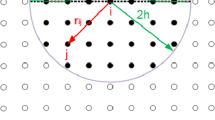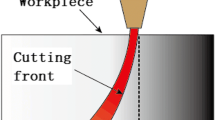Abstract
This research work introduces a model to predict the kerf profile in abrasive water jet slot milling in aluminium 7075-T651. The experimentation allowed modelling the maximum cutting depth and the width at the half of maximum depth in terms of four process parameters: pressure, abrasive mass flow rate, stand-off distance, and traverse feed rate. It is shown that the introduction of the maximum depth and the width at the half of maximum depth in a Gaussian function is suitable to describe the kerf profile. The definition of an equivalent traverse feed rate at every instant along the jet trajectory introduces the effect of the jet acceleration in the model. Thus, the model is capable of predicting the kerf profile at constant traverse feed rate and at variable traverse feed rate due to direction changing trajectories. The variations of cutting depth along a slot are also studied in order to avoid the cutting parameters combinations which lead to low repetitiveness conditions and then irregular milling surfaces.
Similar content being viewed by others
References
Öjmertz KMC (1997) A study on abrasive waterjet milling. PhD Thesis, Chalmers Univer. of Tech., Göteborg, Sweden
Hashish M (1987) Milling with abrasive waterjets: a preliminary investigation. In: Proc. of the 4th U.S. Water Jet Conf., Berkeley, California, 179-188
Paul S, Hoogstrate AM, van Luttervelt CA, Kals HJJ (1998) An experimental investigation of rectangular pocket milling with abrasive water jet. J Mater Process Technol 73:179–188
Öjmertz KMC (1993) Abrasive waterjet milling—an experimental investigation. In: Proc. of 7th Am.Water Jet Conf., Seattle, USA, 777-791
Öjmertz KMC, Jonasson M, Holmqvist G (1996) Analysis of surfaces produced by abrasive waterjet milling techniques. In: Proc. of 13th Int. Conf. on Jetting Tech., Sardinia, Italy, 753-768.
Öjmertz KMC, Amini N (1994) A discrete approach to the abrasive waterjet milling process. In: Proc. of 12th Int. Conf. on Jet Cutting Tech., Rouen, France, 425-434
Jurisevic B, Kramar D, Heiniger KC, Junkar M (2003) New perspectives in 3D abrasive water jet precision manufacturing. In: The 36th CIRP-Int. Semin. on Manuf. Syst., Saarbruecken, Germany.
Freist B, Haferkamp H, Laurinat A, Louis H (1989) Abrasive jet machining of ceramic products. In: Proc. of 5th Am. Water Jet Conf., Toronto, Canada, 191-204
Laurinat A, Louis H, Meier-Wiechert GA (1993) Model for milling with abrasive water jets. In: Proc. of 7th Am. Water Jet Conf., Seattle, USA
Srinivasu D, Axinte D, Shipway P, Folkes J (2009) Influence of kinematic operating parameters on kerf geometry in abrasive waterjet machining of silicon carbide ceramics. Int J Mach Tool Manuf 49:1077–1088
Lebar A, Junkar M (2003) Simulation of abrasive waterjet machining based on unit event features. Proc. Instn Mech. Engrs 217 Part B: J Eng Manuf
Orbanic H, Junkar M (2003) Cellular automata in mechanical engineering. In: 6th Int.Conf. on Manag. of Innov. Tech., Piran, Slovenia, 139-147
Chen L, Siores E (2003) The effect of cutting jet variation on surface striation formation in abrasive water jet cutting. J Mater Process Technol 135:1–5
Henning A, Westkämper E (2003) Modelling of wear mechanics at the abrasive waterjet cutting front. In: Proc. of the 2003 WJTA Am. Waterjet Conf., Houston, Texas, paper 3-A
Momber AW, Kovacevic R (1997) Principles of abrasive water jet machining. Springer, Texas, USA
Shipway P, Fowler G, Pashby I (2005) Characteristics of the surface of a titanium alloy following milling with abrasive waterjets. Wear 258:123–132
Fowler G, Shipway P, Pashby I (2005) Abrasive water-jet controlled depth milling of Ti6Al4V alloy—an investigation of the role of jet-workpiece traverse speed and abrasive grit size on the characteristics of the milled material. J Mater Process Technol 161:407–414
Chen L, Siores E, Wong WCK (1996) Kerf characteristics in abrasive waterjet cutting of ceramic materials. Int J Mach Tool Manu 36:1201–1206
Chen L, Siores E, Wong WCK (1998) Optimising abrasive waterjet cutting of ceramic materials. J Mater Process Tech 74:251–254
Author information
Authors and Affiliations
Corresponding author
Rights and permissions
About this article
Cite this article
Alberdi, A., Rivero, A., López de Lacalle, L.N. et al. Effect of process parameter on the kerf geometry in abrasive water jet milling. Int J Adv Manuf Technol 51, 467–480 (2010). https://doi.org/10.1007/s00170-010-2662-y
Received:
Accepted:
Published:
Issue Date:
DOI: https://doi.org/10.1007/s00170-010-2662-y




